service SKODA OCTAVIA 2005 1.G / (1U) Owner's Guide
[x] Cancel search | Manufacturer: SKODA, Model Year: 2005, Model line: OCTAVIA, Model: SKODA OCTAVIA 2005 1.G / (1U)Pages: 315, PDF Size: 11.8 MB
Page 254 of 315
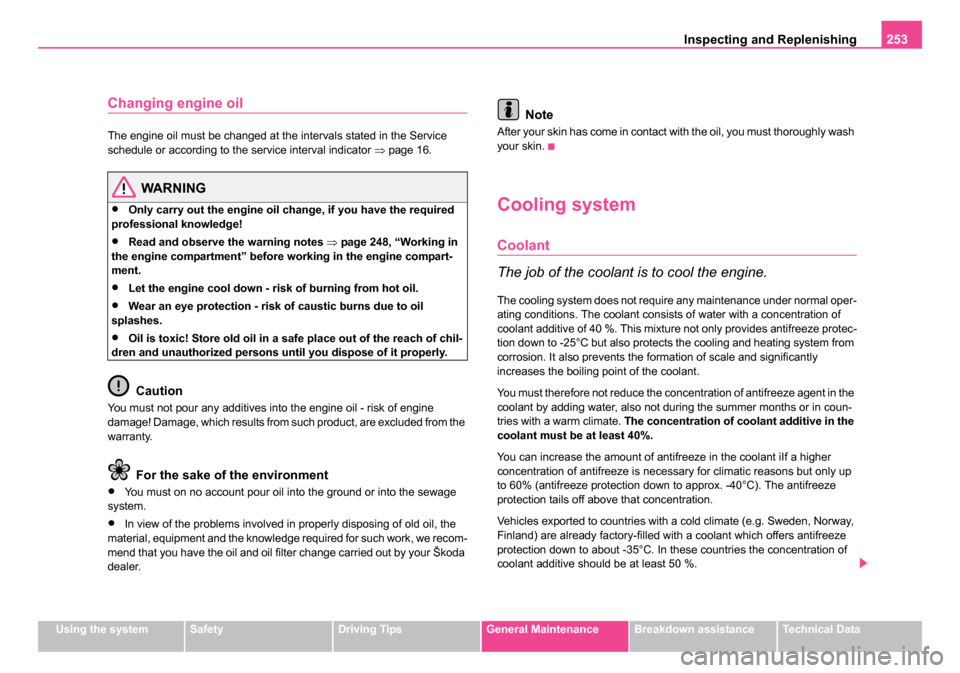
Inspecting and Replenishing253
Using the systemSafetyDriving TipsGeneral MaintenanceBreakdown assistanceTechnical Data
Changing engine oil
The engine oil must be changed at the intervals stated in the Service
schedule or according to the service interval indicator ⇒page 16.
WARNING
•Only carry out the engine oil change, if you have the required
professional knowledge!
•Read and observe the warning notes ⇒page 248, “Working in
the engine compartment” before working in the engine compart-
ment.
•Let the engine cool down - risk of burning from hot oil.
•Wear an eye protection - risk of caustic burns due to oil
splashes.
•Oil is toxic! Store old oil in a safe place out of the reach of chil-
dren and unauthorized persons until you dispose of it properly.
Caution
You must not pour any additives into the engine oil - risk of engine
damage! Damage, which results from such product, are excluded from the
warranty.
For the sake of the environment
•You must on no account pour oil into the ground or into the sewage
system.
•In view of the problems involved in properly disposing of old oil, the
material, equipment and the knowledge required for such work, we recom-
mend that you have the oil and oil filter change carried out by your Škoda
dealer.
Note
After your skin has come in contact with the oil, you must thoroughly wash
your skin.
Cooling system
Coolant
The job of the coolant is to cool the engine.
The cooling system does not require any maintenance under normal oper-
ating conditions. The coolant consists of water with a concentration of
coolant additive of 40 %. This mixture not only provides antifreeze protec-
tion down to -25°C but also protects the cooling and heating system from
corrosion. It also prevents the formation of scale and significantly
increases the boiling point of the coolant.
You must therefore not reduce the concentration of antifreeze agent in the
coolant by adding water, also not during the summer months or in coun-
tries with a warm climate. The concentration of coolant additive in the
coolant must be at least 40%.
You can increase the amount of antifreeze in the coolant iIf a higher
concentration of antifreeze is necessary for climatic reasons but only up
to 60% (antifreeze protection down to approx. -40°C). The antifreeze
protection tails off above that concentration.
Vehicles exported to countries with a cold climate (e.g. Sweden, Norway,
Finland) are already factory-filled with a coolant which offers antifreeze
protection down to about -35°C. In these countries the concentration of
coolant additive should be at least 50 %.
s24s.book Page 253 Thursday, November 24, 2005 12:27 PM
Page 258 of 315
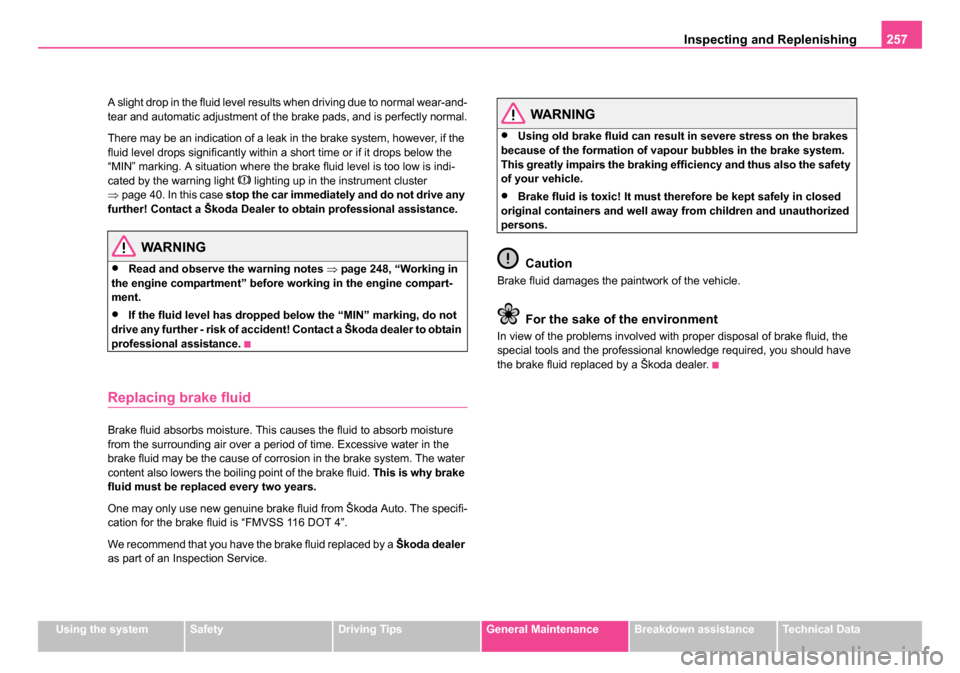
Inspecting and Replenishing257
Using the systemSafetyDriving TipsGeneral MaintenanceBreakdown assistanceTechnical Data
A slight drop in the fluid level results when driving due to normal wear-and-
tear and automatic adjustment of the brake pads, and is perfectly normal.
There may be an indication of a leak in the brake system, however, if the
fluid level drops significantly within a short time or if it drops below the
“MIN” marking. A situation where the brake fluid level is too low is indi-
cated by the warning light
lighting up in the instrument cluster
⇒ page 40. In this case stop the car immediately and do not drive any
further! Contact a Škoda Dealer to obtain professional assistance.
WARNING
•Read and observe the warning notes ⇒page 248, “Working in
the engine compartment” before working in the engine compart-
ment.
•If the fluid level has dropped below the “MIN” marking, do not
drive any further - risk of accident! Contact a Škoda dealer to obtain
professional assistance.
Replacing brake fluid
Brake fluid absorbs moisture. This causes the fluid to absorb moisture
from the surrounding air over a period of time. Excessive water in the
brake fluid may be the cause of corrosion in the brake system. The water
content also lowers the boiling point of the brake fluid. This is why brake
fluid must be replaced every two years.
One may only use new genuine brake fluid from Škoda Auto. The specifi-
cation for the brake fluid is “FMVSS 116 DOT 4”.
We recommend that you have the brake fluid replaced by a Škoda dealer
as part of an Inspection Service.
WARNING
•Using old brake fluid can result in severe stress on the brakes
because of the formation of vapour bubbles in the brake system.
This greatly impairs the braking efficiency and thus also the safety
of your vehicle.
•Brake fluid is toxic! It must therefore be kept safely in closed
original containers and well away from children and unauthorized
persons.
Caution
Brake fluid damages the paintwork of the vehicle.
For the sake of the environment
In view of the problems involved with proper disposal of brake fluid, the
special tools and the professional knowledge required, you should have
the brake fluid replaced by a Škoda dealer.
s24s.book Page 257 Thursday, November 24, 2005 12:27 PM
Page 261 of 315
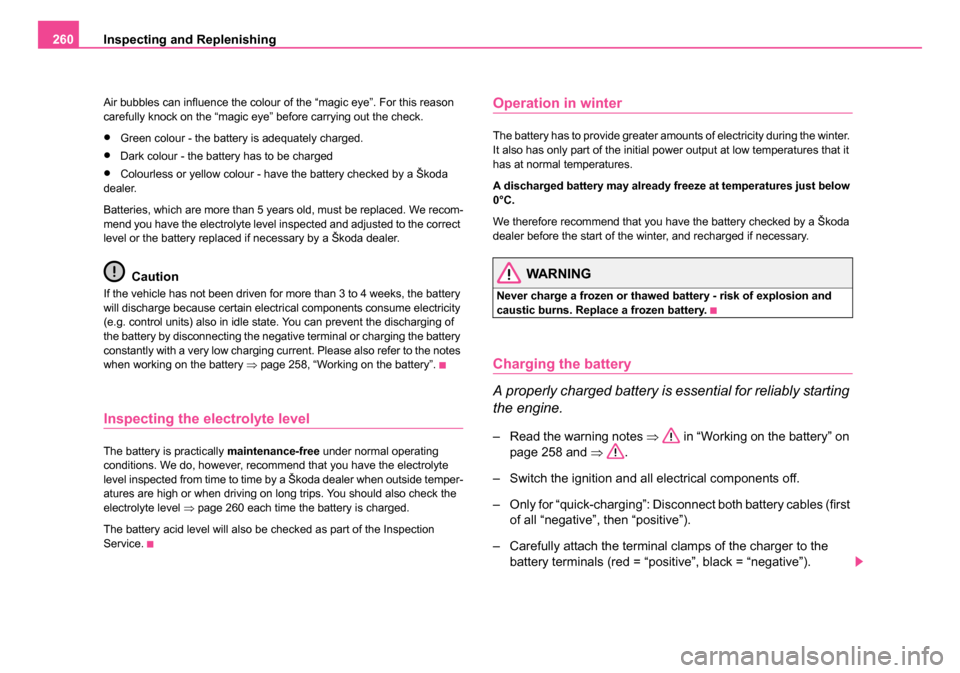
Inspecting and Replenishing
260
Air bubbles can influence the colour of the “magic eye”. For this reason
carefully knock on the “magic eye” before carrying out the check.
•Green colour - the battery is adequately charged.
•Dark colour - the battery has to be charged
•Colourless or yellow colour - have the battery checked by a Škoda
dealer.
Batteries, which are more than 5 years old, must be replaced. We recom-
mend you have the electrolyte level inspected and adjusted to the correct
level or the battery replaced if necessary by a Škoda dealer.
Caution
If the vehicle has not been driven for more than 3 to 4 weeks, the battery
will discharge because certain electrical components consume electricity
(e.g. control units) also in idle state. You can prevent the discharging of
the battery by disconnecting the negative terminal or charging the battery
constantly with a very low charging current. Please also refer to the notes
when working on the battery ⇒page 258, “Working on the battery”.
Inspecting the electrolyte level
The battery is practically maintenance-free under normal operating
conditions. We do, however, recommend that you have the electrolyte
level inspected from time to time by a Škoda dealer when outside temper-
atures are high or when driving on long trips. You should also check the
electrolyte level ⇒page 260 each time the battery is charged.
The battery acid level will also be checked as part of the Inspection
Service.
Operation in winter
The battery has to provide greater amounts of electricity during the winter.
It also has only part of the initial power output at low temperatures that it
has at normal temperatures.
A discharged battery may already freeze at temperatures just below
0°C.
We therefore recommend that you have the battery checked by a Škoda
dealer before the start of the winter, and recharged if necessary.
WARNING
Never charge a frozen or thawed battery - risk of explosion and
caustic burns. Replace a frozen battery.
Charging the battery
A properly charged battery is essential for reliably starting
the engine.
– Read the warning notes ⇒ in “Working on the battery” on
page 258 and ⇒.
– Switch the ignition and all electrical components off.
– Only for “quick-charging”: Disconnect both battery cables (first of all “negative”, then “positive”).
– Carefully attach the terminal clamps of the charger to the battery terminals (red = “positive”, black = “negative”).
s24s.book Page 260 Thursday, November 24, 2005 12:27 PM
Page 287 of 315
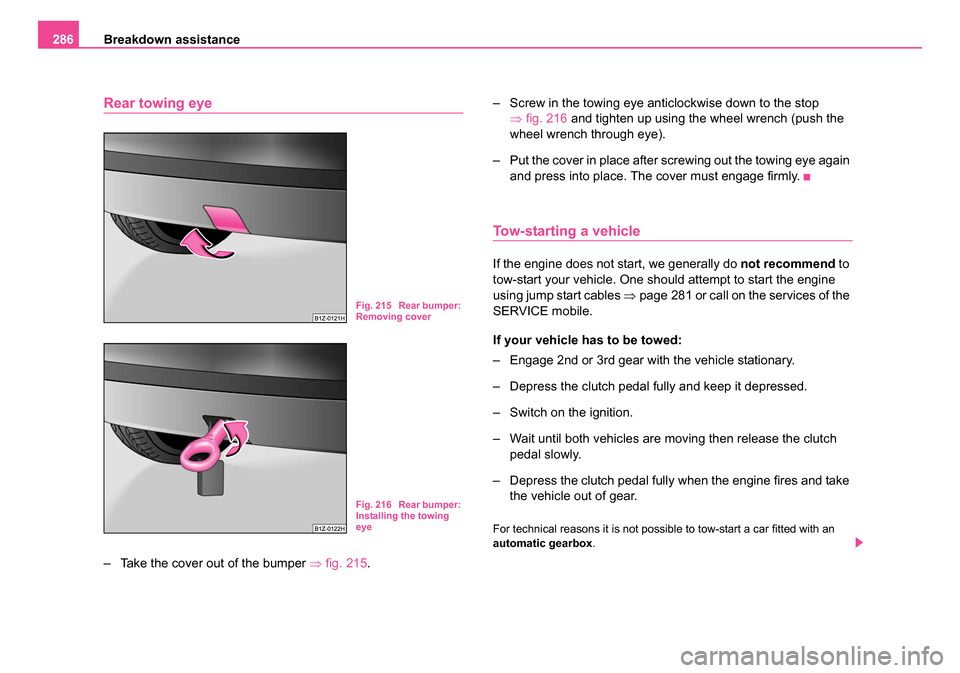
Breakdown assistance
286
Rear towing eye
– Take the cover out of the bumper ⇒fig. 215 . – Screw in the towing eye anticlockwise down to the stop
⇒fig. 216 and tighten up using the wheel wrench (push the
wheel wrench through eye).
– Put the cover in place after screwing out the towing eye again and press into place. The cover must engage firmly.
Tow-starting a vehicle
If the engine does not start, we generally do not recommend to
tow-start your vehicle. One should attempt to start the engine
using jump start cables ⇒page 281 or call on the services of the
SERVICE mobile.
If your vehicle has to be towed:
– Engage 2nd or 3rd gear with the vehicle stationary.
– Depress the clutch pedal fully and keep it depressed.
– Switch on the ignition.
– Wait until both vehicles are moving then release the clutch pedal slowly.
– Depress the clutch pedal fully when the engine fires and take the vehicle out of gear.
For technical reasons it is not possible to tow-start a car fitted with an
automatic gearbox .
Fig. 215 Rear bumper:
Removing cover
Fig. 216 Rear bumper:
Installing the towing
eye
s24s.book Page 286 Thursday, November 24, 2005 12:27 PM
Page 304 of 315
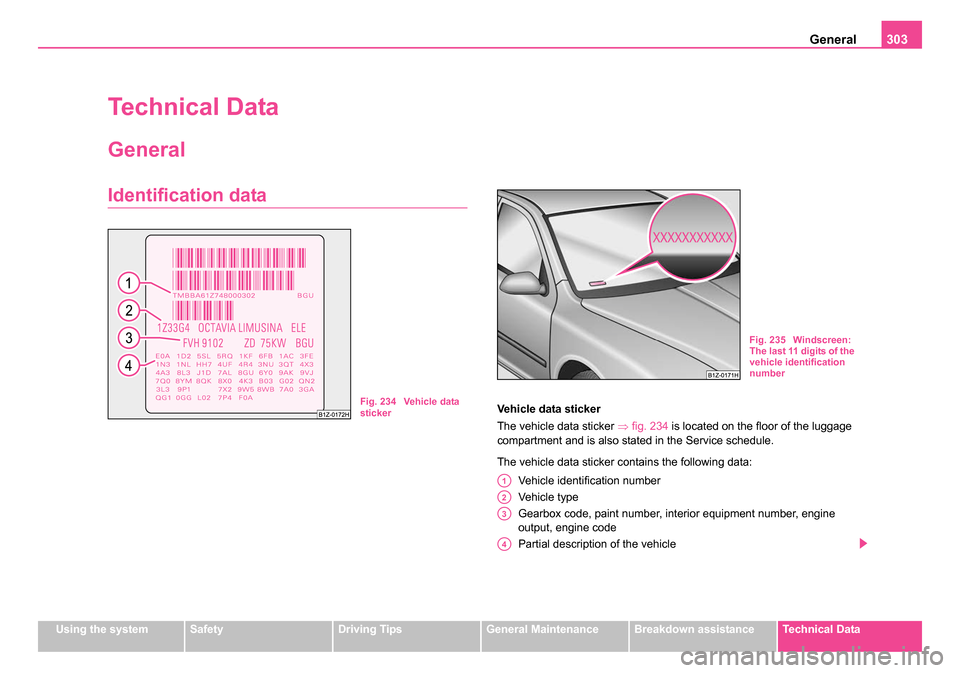
General303
Using the systemSafetyDriving TipsGeneral MaintenanceBreakdown assistanceTechnical Data
Technical Data
General
Identification data
Vehicle data sticker
The vehicle data sticker ⇒fig. 234 is located on the floor of the luggage
compartment and is also stated in the Service schedule.
The vehicle data sticker contains the following data:
Vehicle identification number
Vehicle type
Gearbox code, paint number, interior equipment number, engine
output, engine code
Partial description of the vehicleFig. 234 Vehicle data
sticker
Fig. 235 Windscreen:
The last 11 digits of the
vehicle identification
number
A1
A2
A3
A4
s24s.book Page 303 Thursday, November 24, 2005 12:27 PM
Page 310 of 315
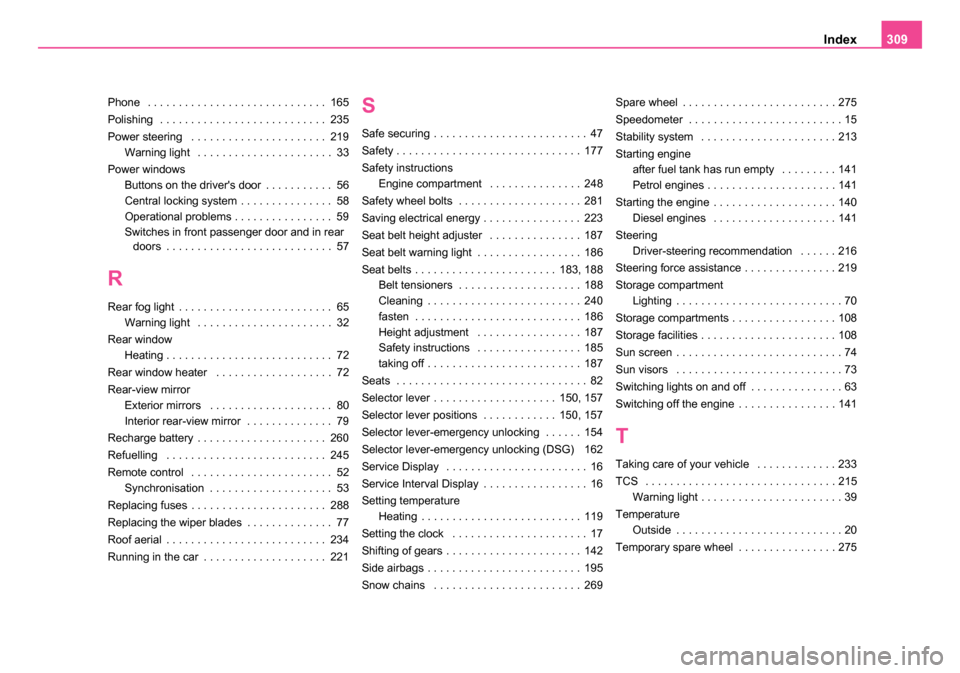
Index309
Phone . . . . . . . . . . . . . . . . . . . . . . . . . . . . . 165
Polishing . . . . . . . . . . . . . . . . . . . . . . . . . . . 235
Power steering . . . . . . . . . . . . . . . . . . . . . . 219
Warning light . . . . . . . . . . . . . . . . . . . . . . 33
Power windows Buttons on the driver's door . . . . . . . . . . . 56
Central locking system . . . . . . . . . . . . . . . 58
Operational problems . . . . . . . . . . . . . . . . 59
Switches in front passenger door and in rear doors . . . . . . . . . . . . . . . . . . . . . . . . . . . 57
R
Rear fog light . . . . . . . . . . . . . . . . . . . . . . . . . 65
Warning light . . . . . . . . . . . . . . . . . . . . . . 32
Rear window Heating . . . . . . . . . . . . . . . . . . . . . . . . . . . 72
Rear window heater . . . . . . . . . . . . . . . . . . . 72
Rear-view mirror Exterior mirrors . . . . . . . . . . . . . . . . . . . . 80
Interior rear-view mirror . . . . . . . . . . . . . . 79
Recharge battery . . . . . . . . . . . . . . . . . . . . . 260
Refuelling . . . . . . . . . . . . . . . . . . . . . . . . . . 245
Remote control . . . . . . . . . . . . . . . . . . . . . . . 52 Synchronisation . . . . . . . . . . . . . . . . . . . . 53
Replacing fuses . . . . . . . . . . . . . . . . . . . . . . 288
Replacing the wiper blades . . . . . . . . . . . . . . 77
Roof aerial . . . . . . . . . . . . . . . . . . . . . . . . . . 234
Running in the car . . . . . . . . . . . . . . . . . . . . 221
S
Safe securing . . . . . . . . . . . . . . . . . . . . . . . . . 47
Safety . . . . . . . . . . . . . . . . . . . . . . . . . . . . . . 177
Safety instructions Engine compartment . . . . . . . . . . . . . . . 248
Safety wheel bolts . . . . . . . . . . . . . . . . . . . . 281
Saving electrical energy . . . . . . . . . . . . . . . . 223
Seat belt height adjuster . . . . . . . . . . . . . . . 187
Seat belt warning light . . . . . . . . . . . . . . . . . 186
Seat belts . . . . . . . . . . . . . . . . . . . . . . . 183, 188 Belt tensioners . . . . . . . . . . . . . . . . . . . . 188
Cleaning . . . . . . . . . . . . . . . . . . . . . . . . . 240
fasten . . . . . . . . . . . . . . . . . . . . . . . . . . . 186
Height adjustment . . . . . . . . . . . . . . . . . 187
Safety instructions . . . . . . . . . . . . . . . . . 185
taking off . . . . . . . . . . . . . . . . . . . . . . . . . 187
Seats . . . . . . . . . . . . . . . . . . . . . . . . . . . . . . . 82
Selector lever . . . . . . . . . . . . . . . . . . . . 150, 157
Selector lever positions . . . . . . . . . . . . 150, 157
Selector lever-emergency unlocking . . . . . . 154
Selector lever-emergency unlocking (DSG) 162
Service Display . . . . . . . . . . . . . . . . . . . . . . . 16
Service Interval Display . . . . . . . . . . . . . . . . . 16
Setting temperature Heating . . . . . . . . . . . . . . . . . . . . . . . . . . 119
Setting the clock . . . . . . . . . . . . . . . . . . . . . . 17
Shifting of gears . . . . . . . . . . . . . . . . . . . . . . 142
Side airbags . . . . . . . . . . . . . . . . . . . . . . . . . 195
Snow chains . . . . . . . . . . . . . . . . . . . . . . . . 269 Spare wheel . . . . . . . . . . . . . . . . . . . . . . . . . 275
Speedometer . . . . . . . . . . . . . . . . . . . . . . . . . 15
Stability system . . . . . . . . . . . . . . . . . . . . . . 213
Starting engine
after fuel tank has run empty . . . . . . . . . 141
Petrol engines . . . . . . . . . . . . . . . . . . . . . 141
Starting the engine . . . . . . . . . . . . . . . . . . . . 140 Diesel engines . . . . . . . . . . . . . . . . . . . . 141
Steering Driver-steering recommendation . . . . . . 216
Steering force assistance . . . . . . . . . . . . . . . 219
Storage compartment Lighting . . . . . . . . . . . . . . . . . . . . . . . . . . . 70
Storage compartments . . . . . . . . . . . . . . . . . 108
Storage facilities . . . . . . . . . . . . . . . . . . . . . . 108
Sun screen . . . . . . . . . . . . . . . . . . . . . . . . . . . 74
Sun visors . . . . . . . . . . . . . . . . . . . . . . . . . . . 73
Switching lights on and off . . . . . . . . . . . . . . . 63
Switching off the engine . . . . . . . . . . . . . . . . 141
T
Taking care of your vehicle . . . . . . . . . . . . . 233
TCS . . . . . . . . . . . . . . . . . . . . . . . . . . . . . . . 215 Warning light . . . . . . . . . . . . . . . . . . . . . . . 39
Temperature Outside . . . . . . . . . . . . . . . . . . . . . . . . . . . 20
Temporary spare wheel . . . . . . . . . . . . . . . . 275
s24s.book Page 309 Thursday, November 24, 2005 12:27 PM
Page 314 of 315
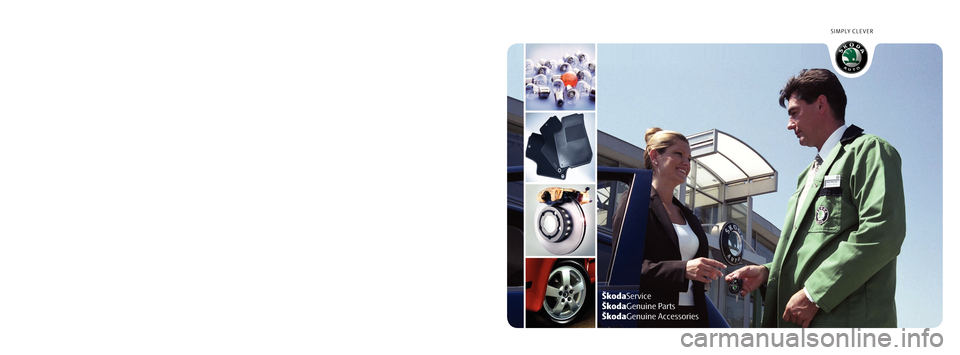
SIMPLY CLEVER
ŠkodaService
ŠkodaGenuine Parts
ŠkodaGenuine Accessories
A5_19_01_06.indd 2
A5_19_01_06.indd 23.7.2006 14:26:34
3.7.2006 14:26:34